Why is Shopify Surpassing Magento?

Have you ever thought why Shopify is becoming popular? Why in a very short span of time, this platform has become the apple of everyone’s eye?
It is Mind Boggling…Isn’t’ It? I hear you guys; let me help you out here. I am not being a Torch bearer, neither am I vouching for Shopify. Having worked in Web designing and development, I am just putting up my views backed up with some practical results that I had seen. Whatever I am delineating is being looked through a user’s/customer’s lens.
Before I hop on to just putting out the text, like taken from google, let me break it down, to help you understand better. So, a website irrespective of their design, look or aesthetics would be deemed well if that has a good UX. There is no point of having a website that look so exquisite and luxe, but with bumpy surfing and messed up navigation.
Shopify being a theme based platform, handled by a single Shopifyteam has a user and beginners friendly backend. This allows users add, omit products, manage inventory and most importantly sort products as per their size or if the festive season is nearby. The better the UX(User Experience), the more would be the propensity for the website. Thus , increasing the online presence for the brand.
If this makes sense, let’s hop on another salient aspect which is interconnected.
An e commerce website with good UI and UX, but not able to generate sales would be worth it? Leave the platform, why would anyone make an e commerce website, knowing that it won’t generate any sales?
Here comes the most important aspect, or I would say the mainstay of this whole blog; “Sales”
Half of the sales are not converted just because the navigation at the website was bumpy, the loading time of the website is more, and this turns people off. Checkout plays an important role.
Majority of the time is spent on choosing the products, narrowing down the items from the bucket list. Now, when you have gotten what you wanted, you would rush to buy it ASAP. A buggy Checkout or a long grueling checkout often spurs people to drop the order.
Shopify provides the smoothest, 2 page checkout. It doesn’t allow the user to make any changes in the checkout. This is the main reason behind having the checkout smooth and hassle free.
Shopify being theme based, at one end limits you to customize it up to an extent. Some people might deem it a downside compared to magneto that allows full customization from scratch. But, limiting people to make changes becomes a boon, as this makes the backend and the whole platform less bumpy and troublesome. The more you customize, yes you can have it all designed you want, but at the same time it makes the platform more prone to coding clashes and compatibility issues. This is attributed to the fact, coding and apps installation from various sources definitely interfere with the platforms and slows down the system.
Shopify gives access to support, ecommerce experts and app partners; you’ll be able to take your business online much faster.
Another major aspect is the plugins, extensions and add ons. Regardless of how well-endowed the website is, there is always a need to incorporate plugins and apps for some bespoke features. Shopify’s App Market is easier to use and offers more polished apps than Magento.
While Magento does have more extensions to offer than Shopify, they require coding knowledge to install, and you run the risk of installing a sub-par extension because anyone is allowed to design them. Plus, there are more bugs in magneto as compared to Shopify.
Now, let say we have a good website with great UI and UX. In order to gain online presence, hosting is required. Here again, Shopify transcends Magento as it as self-hosted platform and you need not to pay separately for hosting.
The beauty of hosting at Shopify is really felt when there are over whelming concurrent users. Be it a festive season or a sale, Shopify has got it covered. There is no need to upscale or downscale the bandwidth for the users unlike Magento. That’s why starting an online store on Shopify is often associated with the ease of scaling – you can upscale or downscale based on what you’re selling and what the market needs, without worrying if your store will be able to handle the changes.
In Magento you need to do it manually or the site would crash. Since it has to be done manually, you lose sales by the time you fix the website crashing by upscaling the bandwidth. This is another major downside of Magento. On the top of that, Magento requires about 40 apps/extensions installed for hosting. Having so many apps installed, are not that compatible, thus leading to some repercussions like making the website more prone to bugs attack and increasing the loading time.
Marketing is great when it comes to Shopify, as the Sync between social media and Shopify is exemplary.
In Shopify, the catalogue syncs every 1 hour. In Magento, the catalogue syncs every 24 hour. So, for instance, if there is a new product upload in a website backend, the product becomes visible within an hour. This entices you to see, and goad you to buy it. Magento plugins cost you a bomb. Shopify plugins go automatic repair and are at cheaper price. On the top of that, Shopify is safe and secured and there is no spamming. This is because, the platform is solely taken care by a single entity, and hence it is used optimally.
Apart from all the articulation of the practical aspects, I am listing some succinct features to help you jumpstart your online presence.
| Shopify | Magento |
| Shopify there are three subscription plans.
Monthly plan 29 $, 79$ and 299 $. The Higher plan u subscribe to, the less transaction fee is charged. |
Hosting has to be paid. Shared hosting could start at $20/month, while dedicated servers start at $539.95/month
Domain-12$ year. |
| SSL with every plan. | SSL certificates- 37$/ yr |
| Domain name- 14$ annually. 9 themes. | Open source platform. It is pricey as the plugging and apps are exorbitant. |
| No tech worries
24/7 customer support |
Since Magento is free. it does not offer any assistance as service. No support as services. |
| Secure & reliable. | Apps plug ins cost you a bomb. |
| Excellent Loading Speed. | |
| Easy app installation. | Complex apps integrations |
| Beginner’s Friendly. | Requires Coding. |
So, the crux is, hands down Shopify is best when it comes to a good, economical and satisfactory website and sales.
You might also like
🌟 We are Shopify Select Partner 🌟
Boost Your Shopify Store with User-Generated Content (UGC)
🪔 Celebrating Deepawali at Digital Impressions 🪔
Let’s chat...
but, you first!
AS SEEN ON









awards

Excellence
in Digital Marketing
Women CPO
of the year 2023
Transformational
Leaders to Watch
Most Trusted
Companies















